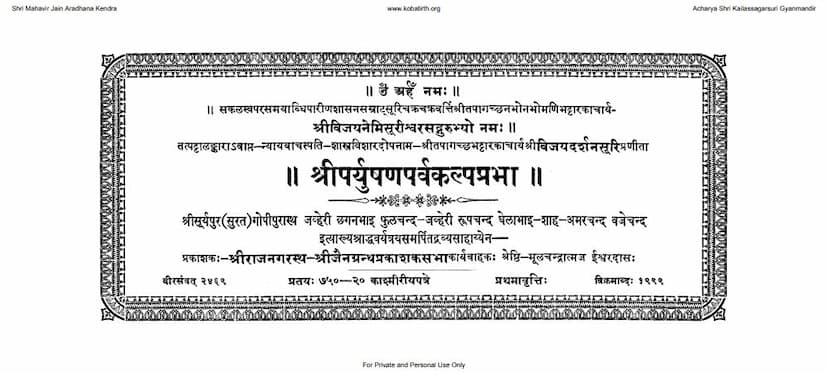Paryushanparv Kalprabha
Added to library: September 2, 2025

Summary
This is a comprehensive summary of the Jain text "Paryushanparv Kalprabha" authored by Acharya Vijaydarshansuri. The text is published by Jain Granth Prakashak Sabha.
Book Title: Shri Paryushan Parva Kalpaprabha Author: Acharya Shri Vijaydarshansuri Publisher: Shri Rajanagar Sth Shri Jain Granth Prakashak Sabha Catalog Link: https://jainqq.org/explore/020545/1
Overall Purpose:
"Paryushan Parv Kalpaprabha" is a detailed guide and commentary on the significance, observance, and benefits of the Paryushan festival in Jainism. It aims to provide a deep understanding of the spiritual practices and their profound impact on the soul's journey towards liberation (moksha). The text emphasizes the importance of the Paryushan festival as a period for purification, penance, and spiritual upliftment.
Key Themes and Content:
The text systematically elaborates on various aspects of the Paryushan festival, drawing heavily on Jain scriptures and philosophical principles. Here's a breakdown of the key themes and their coverage:
-
Significance and Injunction of Paryushan:
- The text establishes the supreme importance of Paryushan as a means to achieve liberation from the cycle of birth and death (bhavashtakanta moksha).
- It asserts that Paryushan is highly worthy of adoration based on scriptural authority and its ability to purify the soul, remove ignorance, and bestow virtues.
- It refutes potential doubts about the necessity of Paryushan by comparing its benefits to the importance of a king with ministers, a warrior with weapons, or a chaste woman with virtue.
-
Nature of Observance (Aradhana):
- Selfless Devotion (Nirashansa Bhava): The festival should be observed with a selfless attitude, not for worldly pleasures or fame, as such desires lead to "nidana" (unfulfilled vows) and are discouraged.
- Poushadh Vrata (Fasting): The text strongly advocates for observing the Poushadh vow, detailing its spiritual benefits, including the accumulation of merit and the potential for binding Devayu (divine lifespan). It explains that even a partial observance is beneficial.
- Importance of Knowledge: It stresses that performing rituals without understanding their meaning or the scriptures is less effective. Therefore, studying and understanding the Kalpa Sutra and other religious texts is crucial.
- Pratikraman (Confession and Repentance): The text emphasizes the necessity of performing pratikraman daily, preferably in the presence of a spiritual preceptor (Guru). It explains the meaning and benefits of pratikraman, which cleanses past deeds and purifies the soul.
- Samayika (Equanimity): The practice of samayika is highlighted as essential for maintaining equanimity, freeing oneself from karmic poisons, and achieving liberation. It is presented as a practice even desirable for celestial beings.
- Praise and Condemnation: The text advises against criticizing others and encourages praising their virtues. Self-criticism and reflection on one's own faults are essential.
- Abstinence from Vices: It details the importance of abstaining from the five vows (panchasanavas): violence, falsehood, stealing, unchastity, and excessive possession.
- Importance of Brahmacharya (Celibacy): The text elaborates on the significance of brahmacharya, citing the exemplary lives of Vijay and Vijaya to illustrate its profound benefits.
- Contentment (Santosh): It advises against greed and emphasizes the virtue of contentment as a spiritual adornment.
- Control of Passions (Kashayas): The text underscores the need to control anger, pride, deceit, and greed, explaining how even a small amount of these passions can negate virtuous deeds.
- Compassion and Non-violence (Ahimsa): It highlights the central role of compassion and non-violence, emphasizing that the purity of intention (bhava) is more critical than external actions.
- Temple Worship (Jin Puja): The text explains the efficacy of worshipping Jain idols with proper rituals and devotion, emphasizing that it purifies the mind and leads to spiritual merit. It also discusses the role of offerings and decorations.
- Penance (Tapa): It strongly advocates for performing penance, both internal (knowledge, meditation) and external (fasting, austerities), as it is essential for shedding accumulated karma and achieving moksha. The story of King Suryayasha is used to illustrate the unwavering commitment to penance even in the face of temptations.
- Charitable Acts: The text encourages acts of charity, including supporting the Jain community (Sangha), helping the needy, and renovating temples. The stories of King Abhū and Vastupala highlight the importance of selfless service to the community.
- Vaiyaavritya (Service to Ascetics): Serving monks and ascetics, especially those engaged in penance, is presented as a highly meritorious act.
- Moral Conduct: The text emphasizes righteous living, adherence to vows, and avoiding sinful activities.
-
Illustrative Stories and Examples:
- The text uses numerous stories and examples from Jain tradition, such as those of King Suryayasha, Chandana and Mrigavati, King Udayan and Chanda Pradyota, and the story of the swan, to illustrate the principles of Jain conduct and the benefits of righteous actions. These stories serve as moral guidance and inspiration.
-
Spiritual Philosophy:
- The text is deeply rooted in Jain philosophy, particularly the concepts of karma, reincarnation, the path to liberation, and the importance of right faith, knowledge, and conduct (Triratna).
- It explains how actions performed with pure intention (bhava) lead to the shedding of karma, while actions performed with impure intentions lead to further bondage.
-
Structure and Style:
- The book is presented as a commentary on the Paryushan festival, offering detailed explanations and justifications for each practice.
- It uses a scholarly Sanskritized language, interspersed with Prakrit verses and references to scriptures.
- The text also includes a list of other works by the author, a corrigendum (shuddhipatraka), and a concluding epilogue (prashasti) and colophon.
In essence, "Paryushan Parv Kalpaprabha" serves as a profound and comprehensive guide for Jain followers to observe the Paryushan festival with utmost devotion, diligence, and understanding, ultimately aiming for spiritual purification and the attainment of eternal bliss.